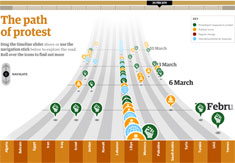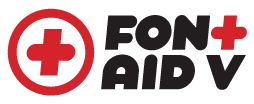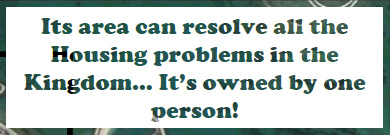March 2011
 ”The US has sent Bahrain dozens of ‘excess’ American tanks, armored personnel carriers, and helicopter gunships. The US has also given the Bahrain Defense Force thousands of .38 caliber pistols and millions of rounds of ammunition, from large-caliber cannon shells to bullets for handguns. To take one example, the US supplied Bahrain with enough .50 caliber rounds—used in sniper rifles and machine guns—to kill every Bahraini in the kingdom four times over.“ Previously: tear gas in Egypt.
”The US has sent Bahrain dozens of ‘excess’ American tanks, armored personnel carriers, and helicopter gunships. The US has also given the Bahrain Defense Force thousands of .38 caliber pistols and millions of rounds of ammunition, from large-caliber cannon shells to bullets for handguns. To take one example, the US supplied Bahrain with enough .50 caliber rounds—used in sniper rifles and machine guns—to kill every Bahraini in the kingdom four times over.“ Previously: tear gas in Egypt.
 “The Society of Typographic Aficionados is organizing Font Aid V — a collaborative project uniting the typographic and design communities with a goal of raising funds to expedite relief efforts after the recent earthquake and tsunami in Japan.” Send in a glyph to be included in a font for sale. The deadline is next Friday: March 25, 2011. Previously: Font Aid IV
“The Society of Typographic Aficionados is organizing Font Aid V — a collaborative project uniting the typographic and design communities with a goal of raising funds to expedite relief efforts after the recent earthquake and tsunami in Japan.” Send in a glyph to be included in a font for sale. The deadline is next Friday: March 25, 2011. Previously: Font Aid IV Mud teaches gardening on a massive scale — across the LA County Unified School District. He raises funds, de-paves urban lots, works with kids, teaches teachers, and Twitters it all. This guy is busy! So it seems appropriate that this interview takes place via Twitter.
Mud teaches gardening on a massive scale — across the LA County Unified School District. He raises funds, de-paves urban lots, works with kids, teaches teachers, and Twitters it all. This guy is busy! So it seems appropriate that this interview takes place via Twitter.Those Other Egyptian Protests

Over at Counterpunch, Esam Al-Amin breaks down key moments in the Egyptian revolution including this wonderful tactic: publicizing fictional protests while the real one(s) assembled:
“Since at least 2004, Egypt has witnessed many protests... In every case, the demonstrators were outnumbered by the security forces, which brutally cracked down on them, causing numerous injuries and arrests.
But the Tunisian revolution changed that equation in several ways. First, it inspired Egyptians beyond the activists or elites. Secondly, once the youth organizers decided to take to the streets on January 25, they outsmarted the security forces.
As a ruse, the youth released announcements for people to gather at certain landmarks and intersections knowing full well that massive security forces would be awaiting them there. Instead, they went in small groups to side streets in poor and middle class neighborhoods with no government agent presence to mobilize these areas to join the protests.
[One of the organizers recounts:] ‘I went to a street in Bulaq Dakrur (one of the poorest neighborhoods in Cairo), where I and a group of members from the movement intended to start protesting. At the same time, other members were doing the same thing in other areas. When we had assembled, we raised the Egyptian flag and began to chant slogans, and it was surprising when a large number of people joined us. This prompted us to take our demonstration down Gamat al-Dawal al-Arabia Street (main street). With increasing numbers joining us, we stopped for some time in front of Mustafa Mahmoud Mosque (major landmark), and then we led the march to Tahrir Square. We found several demonstrations coming from different areas towards this area, and thus we decided to occupy Tahrir Square.’
To the complete surprise of the security forces, the demonstrators reached Tahrir Square numbering over one hundred thousand, which they could neither control nor disperse. Despite the existence of thousands of security forces, this was a new situation that they had not experienced before.”

A unionized public employee, a tea party member, and a CEO

are sitting at a table. In the middle of the table is a plate with a dozen cookies on it. The CEO reaches across and takes 11 cookies, looks at the tea party member and says, “Watch out for that union guy. He wants a piece of your cookie.”
Saw this making the rounds on Facebook and other forums — so much so, that I was unable to track down the source. It glosses over a bit, but does a good job telling a powerful story in simple, visual terms. A nice bit of information design!
Google Earth and the Middle East
Ogle Earth runs down a brief list of ways Google Earth and the availability of satellite imagery in recent years have fueled class resentment and conflict in Bahrain, Iran, Iraq, Israel, Saudi Arabia, Sudan, Syria, Tunisia, and Yemen.
Leading the list are dramatic visualizations comparing the overcrowded living conditions of the Shiite majority in Bahrain with the palaces, estates, and private islands of the ruling families. After the country’s ISPs were ordered to block access to Google Earth’s imagery in 2006, this PDF of annotated screencaps illustrating the spatial inequities circulated widely by email.
Train

From an article on Brenda Brathwaite and her game design:
“[Train] unfolds atop a shattered window. Three model train tracks run diagonally across the broken glass. Game pieces include two stacks of cards, a black typewriter holding the rules, 60 yellow wooden pawns, and six gray model boxcars.
Each turn, players can roll a die and choose to advance their boxcar or load it with pawns; alternatively, they can use a card to speed or slow a boxcar’s progress. Brathwaite’s goal, she says, was to make a game about complicity.…
At that point, Train had not formally revealed its subject, and Jon and the others played as though it were a normal board game, trying to outrace each other. When Rob was the first to move a boxcar to the end of the line, he followed the rules and drew a Terminus card. Train’s theme was no longer hidden. The card said ‘Dachau.’
…
Train is the third title in a series of six non-digital games she calls ‘The Mechanic Is The Message.’ The series was sprung one afternoon in 2007, when her daughter Maezza followed a thoughtless rehash of the day’s school lesson about the Middle Passage by asking to play a game. Brathwaite invented a game on the spot. She had Maezza spend half an hour painting wooden pawns and grouping them into families. Brathwaite then scooped the pawns at random, placed them on an index card, and explained the rules: You have 10 turns to cross the ocean and 30 units of food; each turn you must roll the die and use that much food. After a series of high rolls, Maezza looked to her mother: ‘Mommy, we’re not going to make it.’
…
[Brathwaite] decided to make games about five more ‘difficult’ subjects: Cromwell’s conquest of Ireland, the Holocaust, the Trail of Tears, illegal immigration, and Haitian poverty. Her goal was more than ‘blast-the-Nazis fun.’ ‘I wanted to do a design exercise to see if you could use game mechanics to express difficult subjects,’ Braithwaite says. ‘Every single atrocity, every single migration of people—there was a system behind it. If you can find that system, you can make a game about it. All games are, is systems.’”


